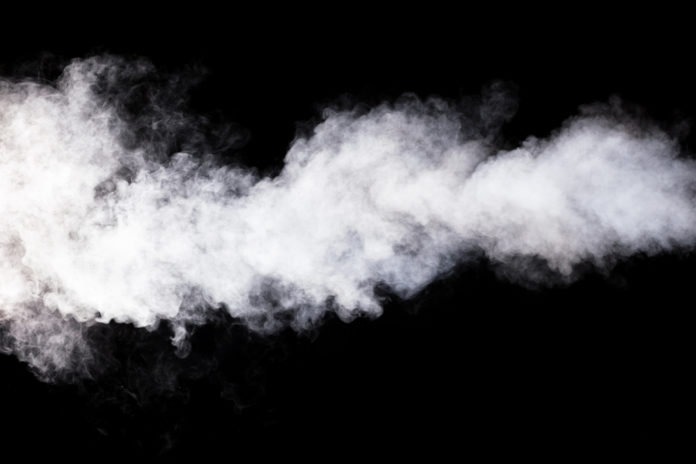“Can you feel it? Nothing can save you, for this is the season of catching the ‘vapers’…” Of course, legendary rapper Biz Markie rhymed about a different type of “vapors” back in 1988. That was old school. This is now and, in 2017, “vape” is officially listed in the dictionary as a word in its own right, and vaping is catching on as a consumption method of first choice for more and more consumers.
“Flower is still far and away our best-selling product, but vape sales, including batteries and cartridges, accounts for approximately 25 percent of our total sales,” said Eric Gaston, co-founder of Evergreen Market. “By far, the most popular form of vaping is with a cartridge that’s pre-filled with oil—typically a half gram, which is then screwed into a rechargeable battery.”
With two locations in Auburn and Renton, Washington, Gaston explained there are two distinct demographics representing vape customers: The niche that prefers dabbing concentrates for increased potency effects, and a growing number of consumers who perceive vape pens and oil cartridges as an easier, cleaner, healthier alternative to the traditional combustion methods.
“While flower comprises the majority of our sales, there is growing interest in oils and concentrates,” said Emma Chasen, general manager for Farma dispensary in Oregon. “In fact, CO2-extracted vape cartridges are our best seller after flower.
“Interest in pre-filled cartridges is growing the fastest,” she added. “People like them because they’re easy to use and discreet, and the product generally has higher cannabinoid concentrations than flower. It helps that one of the biggest objections people have had to pre-filled cartridges and their reliability is being addressed by the industry.”
Gaston also pointed to early hardware malfunctions that may have slowed vape market growth and created some wary customers who got burned, sometimes literally, by early versions.
“Given the high failure rate of many of the earlier cartridges—leaking, breaking, not working, etc.—there are new types of cartridges coming out all the time,” Gaston said. “The trend seems to be toward ‘wickless’ cartridges, which seem to work a little better and provide a better tasting vapor.”
Continuing technology advances are poised to move the market more mainstream. Mobile, discreet, and less lung-damaging than smoking, vape devices range from inexpensive disposables to kits that can costs hundreds of dollars. The mail-order, toaster-sized, tabletop “potpourri atomizer” used to vape flower rapidly has become a reminder of a less mobile era, when you kept your cannabis usage at home and undercover.
In 2014, comedian Sarah Silverman famously rocked her “pot” pen on the Emmy red carpet and, since then, loads of celebrities have been snapped publicly with their vape rig, including Leonardo DiCaprio at the 2016 SAG Awards (presumably for help quitting tobacco,), Whoopi Goldberg (who wrote a blog post to her pen), and Miley Cyrus (who told the Tonight Show that DiCaprio needs to pass that “shit” at the next show.
For celebrity vapers, high-end gear is becoming the latest cool status gadget, like the latest cellphone or digital app, especially since everything—including vape pens—now comes with apps. Despite the trendsetters, retailers report many customers still need a lot of information and education about “how to vape.”
“I think in five years the technology will be to the point where customers will be able to vape all concentrates—shatter, oil, hash, rosin, etc.—as easily as vaping the oil now.” — Eric Gaston
At Farma, Chasen explained, “We set aside time to teach our customers about vaping. We have long emphasized micro-dosing, and vaping is still the best way to deliver smaller amounts of cannabinoids and terpenes to the endocannabinoid system. Plus, vaping flower allows users to receive the full matrix of compounds in cannabis without the negative impacts of smoking.
“For someone new to vaping flower, we suggest starting with a relatively inexpensive delivery method,” she continued. “The effects from vaping can be quite different from the effects of smoking cannabis, so we want our customers to make sure vaping works for them before investing further.
“With pre-filled CO2 cartridges, the idea is even simpler and more potent: attach the cartridge to the battery and inhale. Part of the challenge, however, is educating customers on troubleshooting in case their cartridge does malfunction,” Chasen said.
For consumers that are still confused about vaping options, Gaston suggested, “The easiest way to start is with a battery that does not have an on and off button but engages upon the draw.
“One of our core values is to educate,” Gaston added, acknowledging the rapidly changing product market, “and we strive to drive this home with all of our sales associates. There is a bit of a learning curve with vaping, and we do our best to educate our customers on the ins-and-outs so they have a great experience.”
Even with growing awareness, Gaston said new vape hardware vendors rarely approach him at Evergreen; more often he sees new cartridges and concentrates coming through. For vendors who have a new line, he suggested checking out what is already carried in the store. Ultimately, he orders product lines that prove to be in-demand with his clientele or, sometimes, products that have generated good buzz in the vape community.
Chasen and her staff curate the vape selection at Farma, which currently features only two lines: Firefly2 and PAX 3. “Both are beautifully designed, easy to use, and offer great customer service with solid warranties,” she said. “We take on a new product if we would spend our own money on it. It has to work, and it can’t be difficult to use. No one wants to read a lengthy manual or deal with multiple moving parts. If the user experience isn’t phenomenal, we won’t recommend it to our customers.”
Since it’s a new year, curious minds want to know: What’s in the future for vaping? Gaston and Chasen had slightly different visions, but both agreed that flower, smoked or vaped, would continue to be a fundamental for consumers.
“I think in five years the technology will be to the point where customers will be able to vape all concentrates—shatter, oil, hash, rosin, etc.—as easily as vaping the oil now,” Gaston predicted. “I expect there will always be those who enjoy the ritual of grinding their flower, loading a bowl, rolling a joint, and just smoking in general, but there will be a large shift toward vaping once the technology allows for the vaping of all concentrates in a way that allows for the convenient and flavorful enjoyment of cannabis.”
Chasen added a caveat: Anytime someone tries to predict anything in the cannabis market, they’re bound to be wrong.
“As a general trend, we believe more people will start vaping flower and whole-plant extracts as the technology continues to improve and the cost of devices inevitably comes down,” she said. “Vaporizing is desirable because it remains the simplest and most effective way to control your dose without sacrificing some of the familiar rituals of cannabis use. We don’t see that changing anytime soon.”












